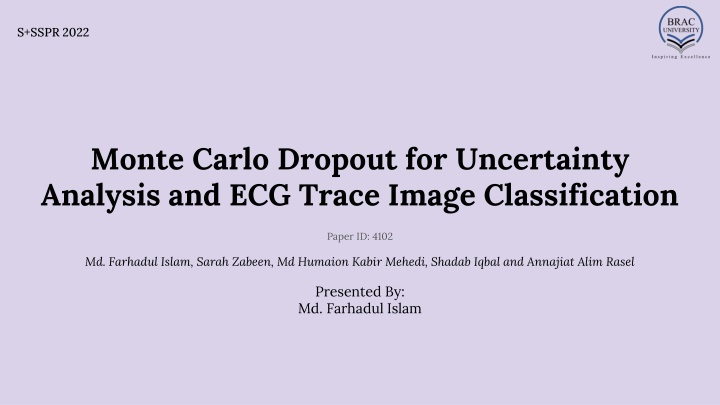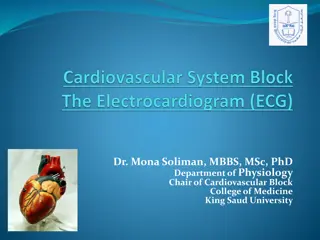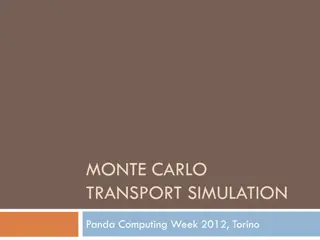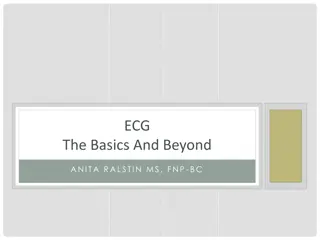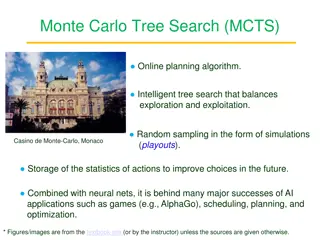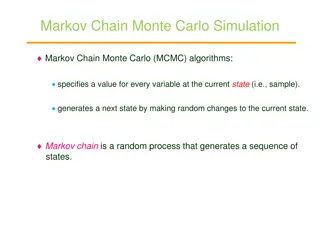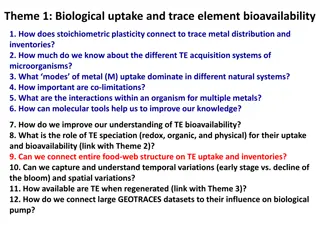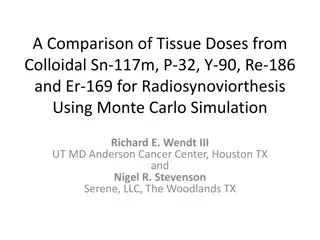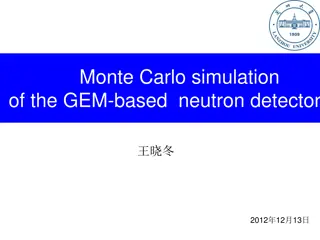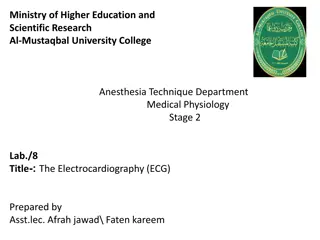Monte Carlo Dropout for Uncertainty Analysis and ECG Trace Image Classification
In this paper, a Monte Carlo Dropout-based Convolutional Neural Network model is proposed for classifying ECG images to improve diagnosis accuracy and reduce uncertainty. The study aims to enhance the reliability of medical image analysis in the context of cardiovascular diseases through advanced deep learning techniques.
Download Presentation

Please find below an Image/Link to download the presentation.
The content on the website is provided AS IS for your information and personal use only. It may not be sold, licensed, or shared on other websites without obtaining consent from the author.If you encounter any issues during the download, it is possible that the publisher has removed the file from their server.
You are allowed to download the files provided on this website for personal or commercial use, subject to the condition that they are used lawfully. All files are the property of their respective owners.
The content on the website is provided AS IS for your information and personal use only. It may not be sold, licensed, or shared on other websites without obtaining consent from the author.
E N D
Presentation Transcript
S+SSPR 2022 Monte Carlo Dropout for Uncertainty Analysis and ECG Trace Image Classification Paper ID: 4102 Md. Farhadul Islam, Sarah Zabeen, Md Humaion Kabir Mehedi, Shadab Iqbal and Annajiat Alim Rasel Presented By: Md. Farhadul Islam
Introduction In 2019, the American Heart Association announced that cardiovascular diseases (CVD) are the major cause of death. It accumulated over 17.6 million deaths in 2016 and the number is estimated to reach 23.6 million by 2030 [1]. A patient suffering from myocardial infarction has a greater chance of recovery the sooner the abnormal cardiac activity is detected by an ECG [2]. An automated ECG diagnostic system using Deep Learning holds the capability to examine the general populace and provide a valuable second opinion for health care practitioners.
Introduction Now, Deep Learning has been successful in medical diagnosis, but Deep Neural Networks can not measure the uncertainty of it s predictions. Uncertain predictions can lead to severe problems in the medical diagnosis. For reducing the risk factors of such issue in CVD diagnosis using ECG trace images, we propose a Monte Carlo Dropout (MCD) based Convolutional Neural Network model. In our work, we - classify five distinct categories of ECG images including COVID-19. - use MCD to analyze the uncertainty of the model - find uncertain samples, for safer diagnosis
Literature Review - ECG Classification In most of the ECG classification studies, the input is either a 1- dimensional numerical ECG signal values [9] or a 2-dimensional image of the ECG signal [10]. Sobahi et al.[12] propose an attention-based 3-dimensional CNN model with residual connections (RC). Attallah et al.[13] develops five distinct DL models. The predictions of three machine learning classifiers is merged using a classification system, which is developed following the implementation of a feature selection approach. The model achieves 91.7% accuracy in three-class classification.
Uncertainty Estimation in Medical Image Analysis Studies regarding uncertainty in DNN prototypes are conducted in order to increase the reliability of the prediction methods. Evaluation of uncertainty in medical applications has been frequently applied for diagnosis of diseases, such as covid-19 [14], tuberculosis [15], and cancer [16] etc. Ghoshal et al.[17] used drop-weights based BNN to quantify uncertainty in DL techniques. They show that the predictive accuracy of the model was notably associated with its uncertainty. Milan s-Hermosilla et al.[18] implement Shallow CNN and with an ensemble model to classify motor imagery. Besides, they use MCD to find the uncertainty of their predictions, which make their model more reliable.
Proposed Methodology We will discuss about the dataset we have utilized, CNN architecture and Monte Carlo Dropout. We focused on developing a lightweight model with reliable diagnosis architecture.
Dataset We use ECG Images dataset of Cardiac and COVID-19 Patients [19], which has 1937 distinct patient records. Data is gathered using ECG Device EDAN SERIES-3 placed in different health institutes across Pakistan. The dataset is a 12-lead based standard ECG images for different patients with five labels such as, COVID-19, Abnormal Heartbeat (HB), Myocardial Infarction (MI), Previous History of MI (PMI), and Normal Person. The majority of cardiac abnormalities cause only slight variations in the ECG data. Such as, a peak-to-peak interval or a particular wave. These differences are frequently used to categorize abnormalities.
Data Preprocessing We have preprocessed the ECG images from the dataset by converting them from RGB (three channel) to grayscale (one channel) images and resizing them into 70 70 resolution. We use the cropped version of this dataset, where the images are cropped according to the ECG leads [20]. This requires less computation cost and better classification performance.
CNN Architecture We use six 2-dimensional convolutional layers and with 3 3 kernel size. To avoid overfitting in the model, we added a batch normalization layer after each convolutional layer. Batch normalization is used, so that we can use a higher learning rate as it allows every layer of the network to do learning more independently. Besides that, we use a max pooling layer after each batch normalization layer with a pool size of 2 2 to reduce the computational cost. As the activation function, we use Relu as the non-saturation of its gradient accelerates the convergence of stochastic gradient descent (SGD) compared to the Sigmoid/Tanh function.
CNN Architecture We flatten the values to single dimension and use 20% dropout from that layer. It is used as the MCD layer. Although batch normalization and dropout are regularization techniques, each of them have different tasks as well other than regularization. During training, dropout modifies the standard deviation of the distribution, whereas it has no effect on the distribution during validation. Unlike dropout, Batch normalization does not do the same. Softmax activation function is added at the end of the output since here all the nodes are classified. The model consists of 488229 parameters.
Monte Carlo Dropout The general purpose of dropout is to decrease the model complexity and prevent overfitting [21]. Can be used as an approximation of probabilistic Bayesian models in deep Gaussian processes, which was presented by Gal and Ghahramani [7]. MCD is a technique of performing numerous stochastic forward passes in a neural network using activated dropout throughout the testing phase to generate an ensemble of predictions that may reflect uncertainty estimations.
Monte Carlo Dropout If we are given a trained neural network model with dropout fnn. To derive the uncertainty for one sample x we collect the predictions of T inferences with different dropout masks. Here represents the model with dropout mask d . So we obtain a sample of the possible model outputs for sample x as
Monte Carlo Dropout We obtain an ensemble prediction by computing the mean and the variance of this sample. The prediction is the mean of the model's posterior distribution for this sample and the estimated uncertainty of the model regarding x.
Experimentation The model has been trained and tested with grayscale images. Converting colored images from the dataset into grayscale images reduced the size or number of unnecessary features of the images. The images are randomly divided into 8:1:1 training, validation, and test datasets, which also maintains the ratio of disease and non-disease classes in every sub-datasets. After an in-depth experiment, we use 32 training samples per iteration, and set the epochs value to 70. We set the learning rate to 0.0001. Because of using batch normalization layers, this learning rate gave us optimal results.
Result Analysis Comparison among different approaches
Result Analysis Distributions of the monte carlo prediction accuracies and prediction accuracy of the ensemble (Red). Uncertain samples and their predictions
Conclusion and Future Work The proposed model makes the computer-aided-diagnosis more reliable and safe. Performance increase and quick diagnosis using images. MCD model in smart watches which are embedded with ECG trackers. More reliable and real time predictions. Can inform experts for dealing with uncertain predictions since many they have calling or messaging feature.
References 1. Benjamin, E. J. et al. Heart Disease and Stroke Statistics-2019 Update: A Report From the American Heart Association. Circulation 139, e56 e528. https://www.ahajournals.org/doi/abs/10.1161/CIR.0000000000000659 (2019). 2. Lown, B., Klein, M. D. & Hershberg, P. I. Coronary and precoronary care. The American Journal of Medicine 46. Symposium on Alherosderosis, 705 724. issn: 0002-9343. https://www.sciencedirect.com/science/article/pii/0002934369900229 (1969). 3. Tajbakhsh, N. et al. Convolutional Neural Networks for Medical Image Analysis: Fine Tuning or Full Training? IEEE Transactions on Medical Imaging 35, 1 1 (Mar. 2016). 4. Begoli, E., Bhattacharya, T. & Kusnezov, D. F. The need for uncertainty quantification in machine-assisted medical decision making. Nature Machine Intelligence (Online) 1 (Jan. 2019). 5. Neal, R. Bayesian Learning via Stochastic Dynamics in Advances in Neural Information Processing Systems (eds Hanson, S., Cowan, J. & Giles, C.) 5 (Morgan-Kaufmann, 1992). https://proceedings.neurips.cc/paper/1992/file/f29c21d4897f78948b91f03172341b7b-Paper.pdf 6. Gal, Y. Uncertainty in Deep Learning PhD thesis (University of Cambridge, 2016). 7. Gal, Y. & Ghahramani, Z. Dropout as a Bayesian Approximation: Representing Model Uncertainty in Deep Learning in Proceedings of The 33rd International Conference on Machine Learning (eds Balcan, M. F. & Weinberger, K. Q.) 48 (PMLR, New York, New York, USA, 20 22 Jun 2016), 1050 1059. https://proceedings.mlr.press/v48/gal16.html. 8. Hong, S., Zhou, Y., Shang, J., Xiao, C. & Sun, J. Opportunities and challenges of deep learning methods for electrocardiogram data: A systematic review. Computers in Biology and Medicine 122, 103801. issn: 0010-4825. https://www.sciencedirect.com/science/article/pii/S0010482520301694 (2020). 9. Attia, Z. et al. An artificial intelligence-enabled ECG algorithm for the identification of patients with atrial fibrillation during sinus rhythm: a retrospective analysis of outcome prediction. The Lancet 394 (Aug. 2019). 10. Jun, T. J. et al. ECG arrhythmia classification using a 2-D convolutional neural network 2018. https://arxiv.org/abs/1804.06812. 11. rmak, E. COVID-19 disease diagnosis from paper-based ECG trace image data using a novel convolutional neural network model. Physical and Engineering Sciences in Medicine 45, 167 179 (Mar. 2022).
References 12. Sobahi, N., Sengur, A., Tan, R.-S. & Acharya, U. R. Attention-based 3D CNN with residual connections for efficient ECG-based COVID-19 detection. Computers in Biology and Medicine 143, 105335. issn: 0010-4825. https://www.sciencedirect.com/science/article/pii/S0010482522001275 (2022). 13. Attallah, O. ECG-BiCoNet: An ECG-based pipeline for COVID-19 diagnosis using Bi-Layers of deep features integration. Computers in Biology and Medicine 142, 105210. issn: 0010- 4825. https://www.sciencedirect.com/science/article/pii/S0010482522000026 (2022). 14. Ghoshal, B. & Tucker, A. On Cost-Sensitive Calibrated Uncertainty in Deep Learning: An application on COVID-19 detection in 2021 IEEE 34th International Symposium on Computer-Based Medical Systems (CBMS) (2021), 503 509. 15. Ul Abideen, Z. et al. Uncertainty Assisted Robust Tuberculosis Identification With Bayesian Convolutional Neural Networks. IEEE Access 8, 22812 22825 (2020). 16. Jungo, A. et al. in, 682 690 (Sept. 2018). isbn: 978-3-030-00927-4. 17. Ghoshal, B. & Tucker, A. Estimating Uncertainty and Interpretability in Deep Learning for Coronavirus (COVID-19) Detection 2020. https://arxiv.org/abs/2003.10769. 18. Milan s-Hermosilla, D. et al. Monte Carlo Dropout for Uncertainty Estimation and Motor Imagery Classification. Sensors 21. issn: 1424-8220. https://www.mdpi.com/1424- 8220/21/21/7241 (2021). 19. Khan, A. H., Hussain, M. & Malik, M. K. ECG Images dataset of Cardiac and COVID-19 Patients. Data in Brief 34, 106762. issn: 2352-3409. https://www.sciencedirect.com/science/article/pii/S2352340921000469 (2021). 20. NKENGUE, M. J. ECG_Image_Cropped https : / / www . kaggle . com /datasets/marcjuniornkengue/ecg-image-cropped Version 4. 2022. 21. Srivastava, N., Hinton, G., Krizhevsky, A., Sutskever, I. & Salakhutdinov, R. Dropout: A Simple Way to Prevent Neural Networks from Overfitting. Journal of Machine Learning Research 15, 1929 1958. http://jmlr.org/papers/v15/srivastava14a.html (2014).
